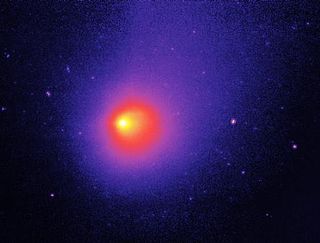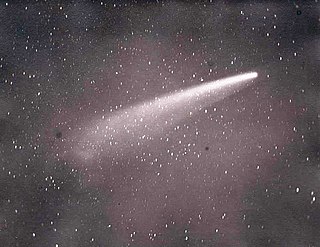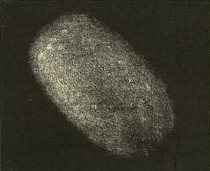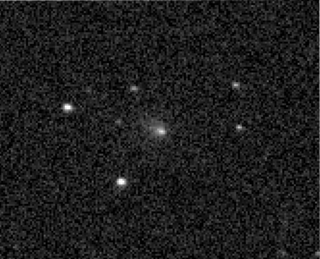
Comet 29P/Schwassmann–Wachmann, also known as Schwassmann–Wachmann 1, was discovered on November 15, 1927, by Arnold Schwassmann and Arno Arthur Wachmann at the Hamburg Observatory in Bergedorf, Germany.

Comet Giacobini–Zinner is a periodic comet in the Solar System. It was discovered by Michel Giacobini, who observed it in the constellation of Aquarius on 20 December 1900. It was recovered two orbits later by Ernst Zinner, while he was observing variable stars near Beta Scuti on 23 October 1913.

The Great Comet of 1882, formally designated as C/1882 R1, 1882 II, and 1882b, was a comet which became very bright in September 1882. It was a member of the Kreutz Sungrazers, a family of comets which pass within 1 R☉ of the Sun's photosphere at perihelion.

Comet Morehouse (modern formal designation: C/1908 R1) was a bright, non-periodic comet discovered by US astronomer Daniel Walter Morehouse on September 1, 1908 (the discovery photograph was taken on September 1, but the comet was not noticed until the following day), at Yerkes Observatory in Williams Bay, Wisconsin. Morehouse was a graduate student at the time. It was unusual in the rapid variations seen in the structure of its tail. At times, the tail seemed to split into up to six separate tails; at others, the tail appeared completely detached from the head of the comet. The tail was further unusual in that it formed while the comet was still 2 AU away from the Sun (where distances of 1.5 AU are more usual), and that there was a high concentration of the CO+ ion in its spectrum.

5D/Brorsen was a periodic Jupiter-family comet discovered on February 26, 1846, by Danish astronomer Theodor Brorsen. The comet was last seen in 1879 and is now considered lost.

105P/Singer Brewster is a periodic comet in the Solar System. It was discovered in 1986, and received the name of 1986d under the old naming system.
4446 Carolyn, provisional designation 1985 TT, is a dark Hildian asteroid from the outermost regions of the asteroid belt, approximately 30 kilometers in diameter. It was discovered on 15 October 1985, by American astronomer Edward Bowell at the Anderson Mesa Station of the Lowell Observatory near Flagstaff, Arizona, in the United States. The asteroid was named after American astronomer Carolyn Shoemaker. It has a longer than average rotation period of 40.9 hours.
147P/Kushida–Muramatsu is a quasi-Hilda comet discovered in 1993 by Japanese astronomers Yoshio Kushida and Osamu Muramatsu.

Comet Arend or 50P/Arend is a periodic comet in the Solar System which was discovered on October 4, 1951. It was discovered by astronomer Sylvain Julien Victor Arend at the Royal Observatory of Belgium located in the municipality of Uccle. The comet was illustrated at approximately a magnitude of 14 and also exhibited a nucleus within a coma 14 arc seconds across. From its discovery, the comet has had 7 perihelions with its last return of Earth recorded on November 1, 2007. The comet's next perihelion will be in the year 2024.

The Great Southern Comet of 1887, or C/1887 B1 using its International Astronomical Union (IAU) designation, was a bright comet seen from the Southern Hemisphere during January 1887. Later calculations indicated it to be part of the Kreutz Sungrazing group. It came to perihelion on 11 January 1877 at a distance of 0.00483 AU (723 thousand km) with a velocity of 606.1 km/s. Since the Sun has a radius of 696000 km, the comet passed about 27000 km from the surface of the Sun.

125P/Spacewatch is a periodic Jupiter-family comet. It was discovered on September 8, 1991, by Tom Gehrels using the 0.91 m Spacewatch telescope at the Kitt Peak National Observatory. It was the first comet discovered with the use of a CCD and also the faintest comet upon discovery up to that point. It has a diameter of 1.6 km.

64P/Swift–Gehrels is a periodic comet in the Solar System which has a current orbital period of 9.23 years.
Comet Latyshev–Wild–Burnham, also known as C/1957 U1, is a faint parabolic comet that was observed during the third week of October 1957. It was the first comet discovered by American astronomer Robert Burnham, Jr., which he co-discovered alongside Turkmen astronomer, Ivan N. Latyshev, and Swiss astronomer, Paul Wild.

Comet Shajn–Comas Solá, formal designation C/1925 F1, is a hyperbolic comet co-discovered by Grigory Shajn and Josep Comas Solá in 1925. At the time, it was the comet with the most distant known perihelion distance, which enabled astronomers to continue observing it until March 1927.
Comet McKenzie–Russell, formally designated as C/1989 Y2, is a hyperbolic comet that was discovered by Australian astronomers, Patricia McKenzie and Kenneth S. Russell on December 1989.

205P/Giacobini is a periodic Jupiter-family comet with an orbital period of 6.68 years. It was discovered by Michel Giacobini on 4 September 1896 and then it was lost until it was recovered by Koichi Itagaki on 10 September 2008. The comet was then found to have fragmented into three pieces.

Comet Tago–Sato–Kosaka, formally designated as C/1969 T1, is a non-periodic comet that became visible in the naked eye between late 1969 and early 1970. It was the first comet ever observed by an artificial satellite.

C/1907 G1 (Grigg–Mellish) is a long-period comet discovered independently by John Grigg and John E. Mellish in April 1907. The comet has been identified as the parent body of the delta Pavonids meteor shower.

Comet Barnard–Denning, also known as C/1891 F1 by its modern nomenclature, is a parabolic comet that was observed through telescopes between March and July 1891. It was discovered by American astronomer, Edward Emerson Barnard, and British astronomer, William Frederick Denning.
Comet Haneda–Campos, formally designated as D/1978 R1, was a periodic comet with a 5.97-year elliptical orbit around the Sun. It was never successfully recovered during its 1984 and 1991 apparitions, and is now considered lost.

















